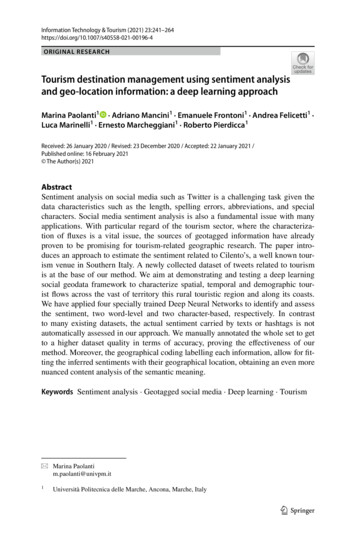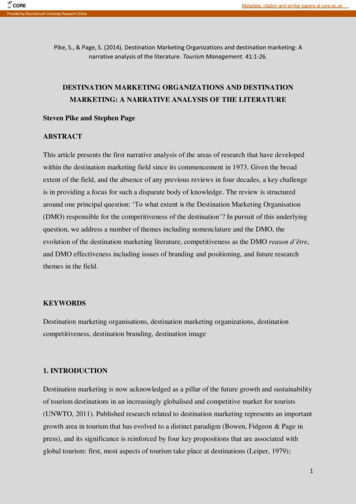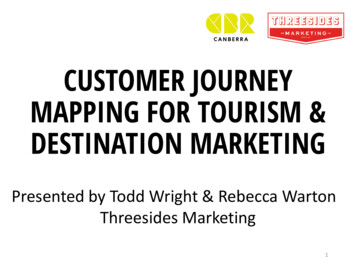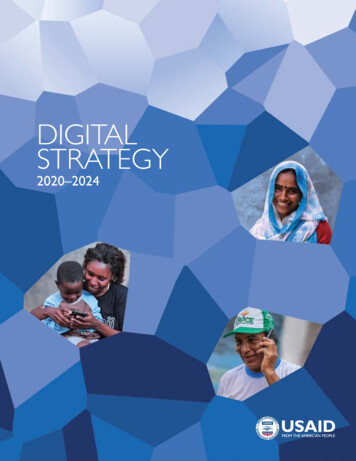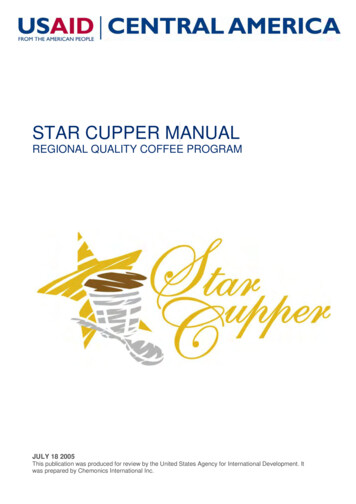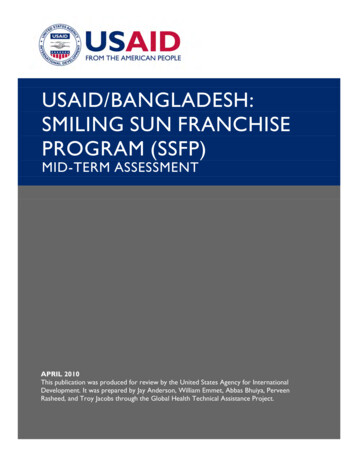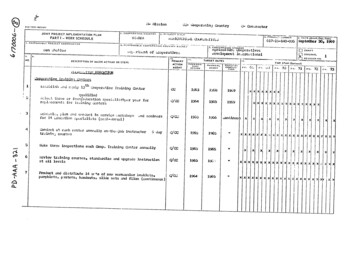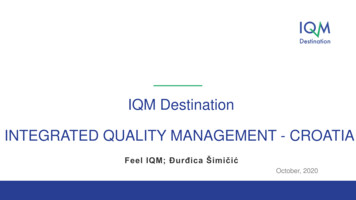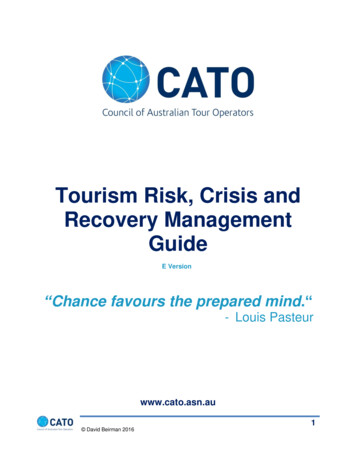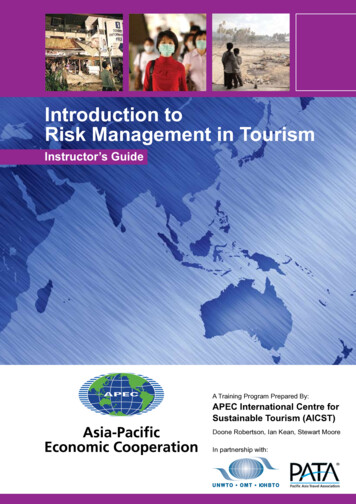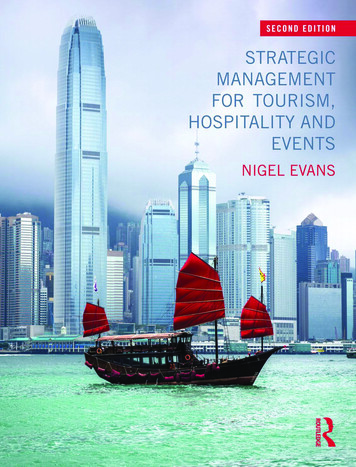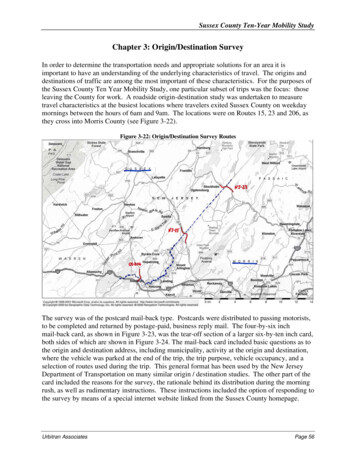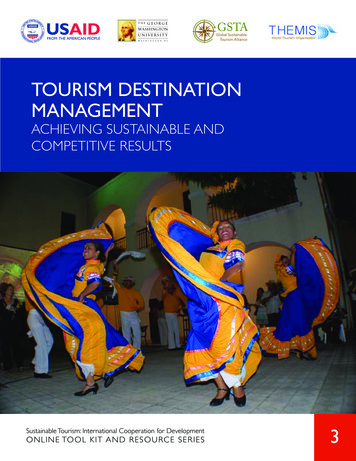
Transcription
GSTAGlobal SustainableTourism AllianceTOURISM DESTINATIONMANAGEMENTACHIEVING SUSTAINABLE ANDCOMPETITIVE RESULTSSustainable Tourism: International Cooperation for DevelopmentO N L I N E TO O L K I T A N D R E S O U R C E S E R I E S3
Sustainable Tourism: International Cooperation for DevelopmentON L IN E TO O L K IT AND RE S O U RCE S E RIE Shttp://lms.rmportal.net/course/category.php?id 51ST101. Global TourismAchieving Sustainable GoalsST102. Project Development for Sustainable TourismA Step by Step ApproachST103. Tourism Destination ManagementAchieving Sustainable and Competitive ResultsST104. Tourism Investment and FinanceAccessing Sustainable Funding and Social Impact CapitalST105. Sustainable Tourism Enterprise DevelopmentA Business Planning ApproachST106. Tourism Workforce DevelopmentA Guide to Assessing and Designing ProgramsST107. Tourism and ConservationSustainable Models and StrategiesST108. Scientific, Academic, Volunteer, and Educational TravelConnecting Responsible Travelers with Sustainable DestinationsST109. Powering TourismElectrification and Efficiency Options for Rural Tourism Facilities
GSTAGlobal SustainableTourism AllianceTOURISM DESTINATIONMANAGEMENTACHIEVING SUSTAINABLE ANDCOMPETITIVE RESULTSSustainable Tourism: International Cooperation for DevelopmentON L I NE TO O L K I T AN D R ES O U R CE S ER I ESPrimary AuthorsJennifer StangeDavid BrownSolimar InternationalContributorsRoberta Hilbruner, USAIDDonald E. Hawkins, George Washington UniversityThis publication is made possible by the support of the American People through the United StatesAgency for International Development to the Global Sustainable Tourism Alliance cooperative agreement#EPP-A-00-06-00002-00. The contents of this publication are the sole responsibility of the author(s) anddo not necessarily reflect the views of USAID or the United States Government.
TABLE OF CONTENTSPreface . 2A Few Confusing Terms . 4Unit 1: Ensuring a Sustainable Form of Development. 8Unit 2: Tourism Inventory, Vision, and Goal Setting. 23Unit 3: Auditing the Visitor and Resident Experience . 47Unit 4: Utilize Clusters to Gain a Competitive Edge . 62Unit 5: Establishing Destination Management Organizational Partnerships. 68Unit 6: Developing Destination Marketing & Positioning Strategies . 81Unit 7: Building the Destination’s Online Presence. 104Unit 8: Developing a Visitor Information Program. 127References . 134Glossary . 137In accordance with Title 17 U.S.C. section 107, any copyrighted material herein is distributed withoutprofit or payment for non-profit research and educational purposes only. If you wish to usecopyrighted materials from this publication for purposes of your own that go beyond “fair use,” youmust obtain permission from the copyright owner.International Institute for Tourism StudiesThe George Washington University 2201 G Street, NWWashington, DC 20052TOURISM DESTINATION MANAGEMENT1
PrefacePeople travel for a variety of reasons: to escape, explore, understand, and participate. But at the coreof the experience lies the destination — the place that hands something to the traveler to keepforever and share with others. This toolkit helps destinations put in place strategies and programsthat will best tell their unique story and become an inviting host for visitors no matter the purpose oftheir journey.Destination management organizations (DMO) are often the only advocates for a holistic tourismindustry in a place; and in this role they ensure the mitigation of tourism’s negative impacts to theenvironment and local communities as well as the sharing of opportunities for a vibrant exchange ofpeople. In fact, a DMO may best serve to facilitate dialogue among the private sector, public sector,and other stakeholders that may otherwise never collaborate or understand how their decisionsreverberate down a destination’s long tourism value chain.Because of this unique capability, DMOs prove invaluable for supporting tourism development,especially in developing destinations where tourism is an important economic driver and mechanismfor equitable social capacity building.Developing a DMO iteratively relies on identifying and redefining a destination vision throughcollaboration. The pages that follow outline how to build a successful DMO to increase visitationwhile preserving a destination’s assets. Every destination is different, however, so no one volumecould ever be a complete resource. The information within hopefully guides the reader to exploremore deeply additional interests and seek out examples of innovation by other organizations aroundthe world.The processes, examples, and tools have been adapted from several years of expertise in the field bytourism professionals. We would like to thank those individuals who — without their diligent workand insight — this toolkit would not be possible: James Dion, Shawndra Herry, Matt Humke, SimonJones, Eric Lin, Juan Luna Kelser, Hamilton McNutt, Jennifer Park, Chris Seek, Natalie Sellier,Ashley Silver, and Jonathan Tourtellot.Drs. Don Hawkins and Kristin Lamoureux of The George Washington University are responsiblefor the education of hundreds of successful individuals — both in the classroom and out. We areboth sincerely thankful to be their students and look forward for every new chance to learn fromthem.We’d also like to thank Roberta Hilbruner, whose unparalleled championing of sustainable tourismhas improved numerous destinations and people throughout the world.TOURISM DESTINATION MANAGEMENT2
The Global Sustainable Tourism Alliance managementpartners — FHI360, The George Washington University,Solimar International, and The Nature Conservancy —provided helpful guidance. We also acknowledge majorcontributions by the following persons: Annessa Kaufmanfor overall coordination of the online programming, TaniaSegura for technical assistance and Jon Kohl for editorialservices.We also express our appreciation to the World TourismOrganization and its Themis Foundation for permission toutilize information from their publications and to pilot testthis publication.And finally, we would like to remember the contributions ofPhoto fromChrystel Cancel, whose life the Haiti Earthquake of 2010http://thetravelword.com/2010/02/13/suddenly took from us while pursuing her passion ofsustainable tourism development. Her talent in engaging andemboldening local people to preserve their place can be seen throughout our many references to theBocas Sustainable Tourism Alliance in Panama, which she led from its inception.The target audience for this manual includes professionals working on tourism-related projects indeveloping countries, including staff from donor and government agencies, NGOs, consulting firms,universities, businesses, and related entities.We hope this publication is a useful resource for the reader — no matter the purpose of the journey.With enthusiasm and gratitude,David C. Brown & Jennifer StangeTOURISM DESTINATION MANAGEMENT3
A Few Confusing TermsThere are a few terms and concepts that often haunt the tourism literature. Here we present severalto avoid confusion. Their definitions and support material come from the World Heritage Center(2007).DESTINATION AND SITESThe market ultimately decides the boundaries of a destination, influenced by marketing, as well asphysical and cultural limits. Thus the market may perceive an entire country as a destination (asmarketed by a tourism ministry) or a single national park, such as Iguazu National Park in Argentina.The term site overlaps significantly with destination but tends to center on a particular place boundby physical or cultural characteristics. Many sites often inhabit a single destination such as theprincipal temples of Tikal National Park, or multiple historical buildings in the Historic Center ofVienna.ATTRACTIONSAn attraction is any object, person, place, or concept that draws people either geographically orthrough remote electronic means so that they might have an experience. The experience can berecreational, spiritual, or otherwise. An attraction is an outstanding example (for whatever criteriaused) of a resource which includes all the elements in a particular class. For example the MonarchButterfly is an attraction among the 1,000s of Lepidoptera species, the resource class of butterfliesand moths, in Mexico. Thousands and thousands of Mayan burial sites exist in Guatemala, yet onlyvery few actually earn the distinction of being an attraction.Ultimately the market — not tourism experts or magazines — decide what is an attraction among itsmuch wider resource class. If people spend time and money to experience a particular resource, thenthat resource is also an attraction.Traditionally, people divide up attractions between cultural and natural. Cultural should, but does notalways, include historical attractions as well. Public Use Planning effort of the World Heritage Centeruses another categorization, perhaps more refined, consisting of four categories:Geophysical-landscape-aesthetic. Includes mountains, gorges, big rocks, rock formations, caves,rivers, water bodies, scenic views, overlooks of forests (when the attraction is merely seeing and notinteracting more directly with the forest), unusual cloud formations, unusual meteorologicalTOURISM DESTINATION MANAGEMENT4
conditions (high velocity or unusual wind behavior, light hitting or passing through geologicalformations in strange ways), thermal waters, volcanic activity, or even unusual celestial events such asthe Northern Lights, Perseid Meteor Showers, or exceptionally clear night views for star-gazing.Ecological-biological. Includes any and all organisms, their parts, their behaviors, aggregations, orassociations in communities with other organisms. It also includes ecological events or processes thatinclude the participation of organisms, such as decomposition, reproduction, predation, migration,and fossil remains (though one could categorize these as geophysical as well).Cultural-historical. Includes all human constructions, practices, and remains (archaeological). Itincludes all manifestations of human evolution and cultural expression. In some cases, it includesideas of particular individuals or events that are interpreted through objects and places like a house ora person’s possession, like some famous philosopher’s eyeglasses or the house of a militarycommander.Recreational. These include all attractions built by humans for the specific purpose of entertainmentor education. This includes theme parks, botanical gardens, sports fields, motion-based attractions(such as roller coasters), zoos, museums, theatres, shopping malls, etc. In the context of protectedareas, this resource category is normally not considered, since the purpose of protecting sites is topreserve and exhibit natural and cultural attractions, not artificial human-based attractions like DisneyWorld. This is not to speak badly of this type of attraction, but since such attractions are normallyincompatible with and compete with protected sites, they sometimes can be left out of protected areaattraction inventories. If they do exist in a site, they can be classified as existing services, designed tosupport the experience of the protected resources.Attractions are often confused with activities and services. See “product” below. Attractions can alsomanifest at a variety of scales, again, depending completely on market perception. For example, alocal attraction may only draw people from a local village such as a mundane fountain in which themayor’s daughter cried after having twin babies. A regional attraction has power to attractiondomestic tourists from throughout a region such as the Basilica and the Virgen de los Ángeles inCosta Rica to which once a year tens of thousands of Costa Ricans walk to offer thanks and askfavors; most of those who walk live nearby. Likewise attractions can draw visitors nationally andinternationally.Attractions can also be nested, one inside another. Durmitor National Park in Montenegro is anattraction in and of itself, but also enjoys the blessings of two major site attractions whose patronsmight care less about the rest of the park. Black Lake draws large numbers of Montenegrins whowould never venture much beyond the picnic tables and the Tara River brings in rafters and kayakersthe world over. Each of these then appeals to a different market segment and would be marketedseparately as well as together.TOURISM DESTINATION MANAGEMENT5
TOURISM PRODUCTSDespite products’ being the central feature of the industry, much confusion washes over the concept.Products like attractions are often confused with the activity and with services, but a product is morethan these. A useful definition comes from the Honduran Institute of Tourism, slightly modified bythe Public Use Planning effort. Though each industry defines product components according to itsown realities, tourism can be thought of as six components aligned in logical sequence.Attraction. All tourism products begin with an attraction, without which no further discussion isneeded.Access. An attraction must have access or else no further discussion is needed. Do note, however,that most often access refers to visitor capacity to arrive. Sometimes access means the opposite.Sometimes an attraction is attractive because it is difficult to get to, such as wilderness areas and foradventure activities. Either way, access is essential to the exploitation of the attraction.Activity. Every visitor experiences an attraction, but how they experience depends on the activitythey select (see “Experience” below). A person can experience Mount Everest vicariously throughthe Internet or from the porch of a cushy mountain lodge. They could also experience it by scalingthe mountain to its death-defying icy peak. Thus it is erroneous to say that Mount Everest offers aparticular kind of experience; it may be short-hand for mountaineering, but experience depends onthe activity.Services. To realize an activity requires services. Services are all those functions that a visitor mightor might not be able to do for him or herself but in all cases chooses someone else to do it for them.Services include actually allowing the activity to take place (such as access granted by a national park),the security of park guards and wilderness responders, the food, the housing, the transportation, thecommunication, the provision of souvenirs, etc. If an activity requires no services (such as using thebackyard of one’s own home), then we are not talking about a tourism product.Qualified personnel. Service provision, in turn, requires that someone qualified provide that service,whether a guide, chef, driver, transportation company, national park staff, police, or street juggler.Even if that someone is an automated robot, it still requires someone (and someone also to servicethe robot, of course).Promotion. Despite the best of tourism product designs, if no one knows the product exists, then allis for naught. A tourism product must also include promotions, even if that is “only” word-of mouth.TOURISM DESTINATION MANAGEMENT6
EXPERIENCESome people might include the experience as one of the tourist components, but no product canprovide an experience, only an opportunity to have an experience. Mount Everest cannot provide anexperience, no matter what kind. The tour operator does not provide an experience. Only the visitorcan create the experience based on certain factors. While there are many ways to define anexperience, Pine and Gilmore (1999) suggest the following equation, redrawn by Public UsePlanning.Figure 1.1. Anatomy of an Experience. (Adapted from Pine & Gilmore, 1999).In Figure 1.1, an experience begins as an event where a visitor experiences (activity) an attraction(resources) within a particular context or situation (high-quality rock climbing equipment with toprated guides or with tattered ropes and a retired green beret). This event generates a reaction (“I likedit!” “I hated it!” “I’m really pretty good at rock climbing after all!”) and that reaction burns a memoryupon which the visitor reflects and creates new meaning. Ultimately the person, through thismeaning-making process, both increases his or her understanding of the world and of the self as well.As the visitors’ confidence increases or decreases, as self-image transforms, in effect, they literally re create themselves, which of course is where the word “recreation” comes from anyway. As the figurefurther points out, interpretive planning and recreation planning influence greatly the event or theopportunity to have an experience.TOURISM DESTINATION MANAGEMENT7
Unit 1: Ensuring a SustainableForm of DevelopmentThis unit was adapted with permission from an article by Jonathan Tourtellot (2010). All material nototherwise cited derives from this source.At the end of this unit, participants will be able to: Distinguish between traditional and sustainable tourism Understand basic principles of sustainable tourism development Identify tools to manage destinations more sustainably Grasp the state of the art of this still-developing field — lessons learned, challenges, and theimportance of key playersTRADITIONAL TOURISM VS. SUSTAINABLE TOURISMYou know the scene: it is high season and today the famous historic site is drawing hundreds maybeeven thousands of visitors. Tourists trail guides with colorful umbrellas held high. You hear routineexplanations about kings, battles, artists, and architecture delivered in English, Japanese, French,Italian, and Arabic.A minister of tourism might look at the scene and smile, “Business is good.” Preservationists mightlook at the scene and fret, “Can the site withstand all this traffic?” Many residents simply avoid thearea, while other more entrepreneurial types rush in with their wares and scams to prey on thecrowds. And many affluent and educated visitors take one look at this scene and hasten elsewhere,“Too touristy!”How to handle all this? In 1960, when affordable jetliners helped to launch the modern-day tourismexplosion, the world experienced fewer than 70 million international arrivals a year. Since then,humankind has grown — a lot. We are more numerous and more affluent, and we want to see newplaces. Tourism’s growth confronts destinations with both opportunity and stress. Now internationalarrivals approach one billion, a fourteen-fold increase in tourism traffic — and that is only a fractionof domestic tourism, which has soared recently in countries with fast-growing middle classes such asChina, Mexico, India, and Brazil.TOURISM DESTINATION MANAGEMENT8
In popular destinations, this increasing visitation offers both challenges and opportunities.Destinations that hope to become popular face a choice: traditional touris
Aug 15, 2011 · TOURISM DESTINATION MANAGEMENT 5 . T OURISM P RODUCTS. Despite products’ being the central feature of the industry, much confusion washes over the concept. Products like attractions are often confused with the activity and with services, but a product is more than these. A useful definition comes from the Honduran Institute of Tourism .
